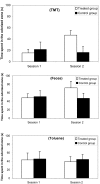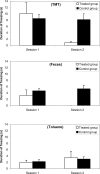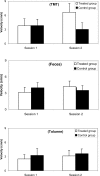Comparative Fear-Related Behaviors to Predator Odors (TMT and Natural Fox Feces) before and after Intranasal ZnSO(4) Treatment in Mice
- PMID: 21206761
- PMCID: PMC3013532
- DOI: 10.3389/fnbeh.2010.00188
Comparative Fear-Related Behaviors to Predator Odors (TMT and Natural Fox Feces) before and after Intranasal ZnSO(4) Treatment in Mice
Abstract
The possibility that synthetic 2,4,5-trimethylthiazoline (TMT), frequently used to induce unconditioned fear in rodents, could be more a pungent odor activating intranasal trigeminal nerve fibers rather than a predator odor index is currently discussed. In order to explore this question, the present study compared fear-related behaviors to predator odors (synthetic 10% TMT and natural fox feces) and toluene (as an irritant compound without ecological significance) before and after intranasal ZnSO(4) perfusion which is known to provoke transient anosmia. Results show that natural fox feces could be consider as a pure olfactory (CN I) nerve stimulant while 10% TMT appeared to be a mixed olfactory (CN I) and trigeminal (CN V) nerves stimulant with a great olfactory power and a low trigeminal power. These findings suggest that behavioral neuroscience studies should use concentrations lower than 10% TMT to obtain fear-related behaviors similar to those obtained with natural fox feces odor.
Keywords: TMT; fear conditioning; fox odor; olfactory nerve; trigeminal nerve; zinc sulfate.
Figures




References
-
- Benaroya-Milshtein N., Hollander N., Apter A., Kukulansky T., Raz N., Wilf A., Yaniv I., Pick C. G. (2004). Environmental enrichment in mice decreases anxiety, attenuates stress responses and enhanced natural killer cell activity. Eur. J. Neurosci. 20, 1341–134710.1111/j.1460-9568.2004.03587.x - DOI - PubMed
LinkOut - more resources
Full Text Sources

